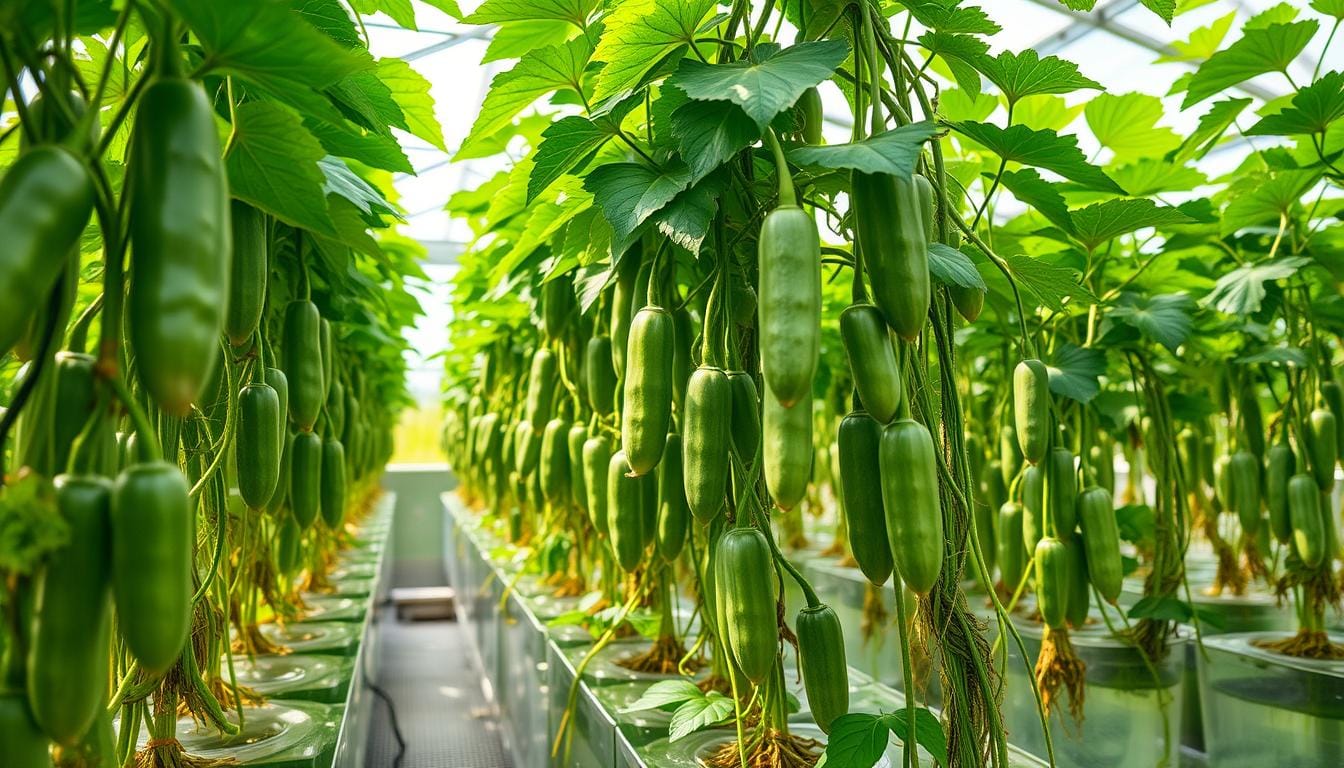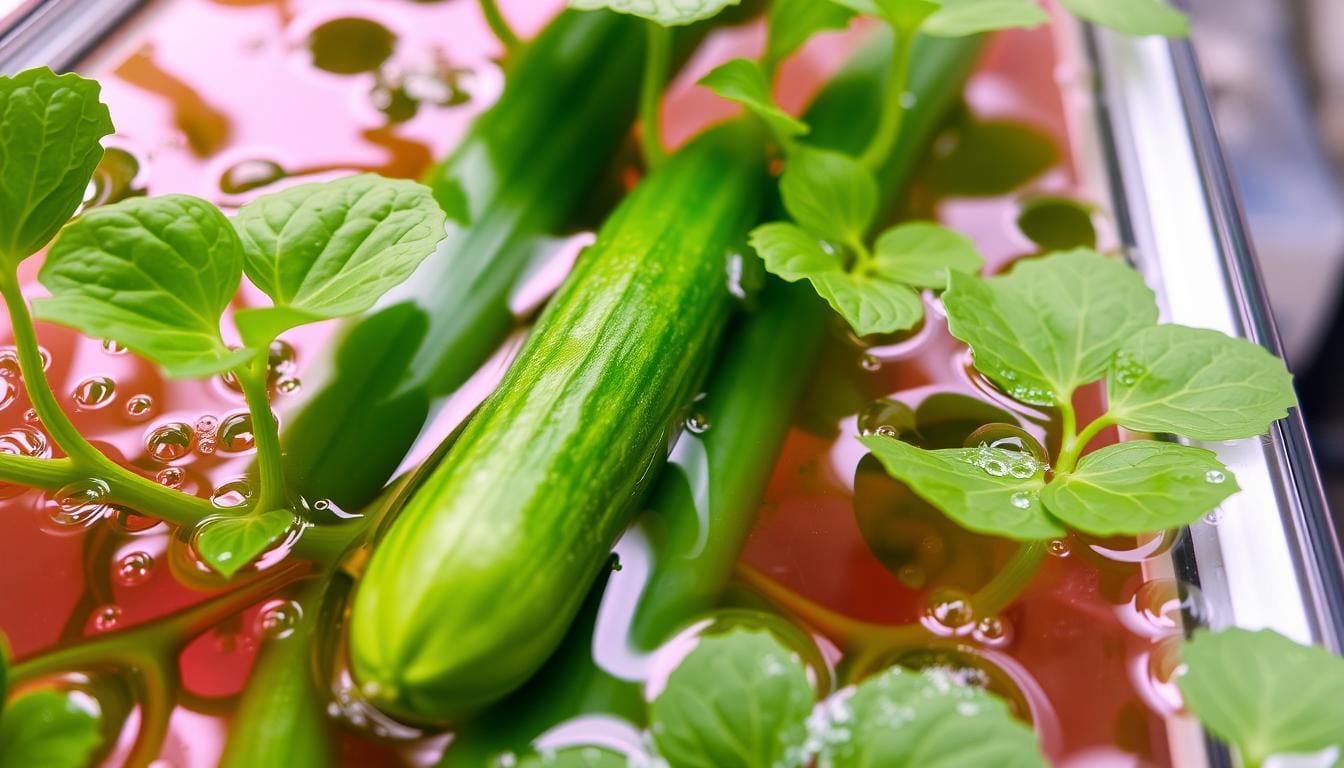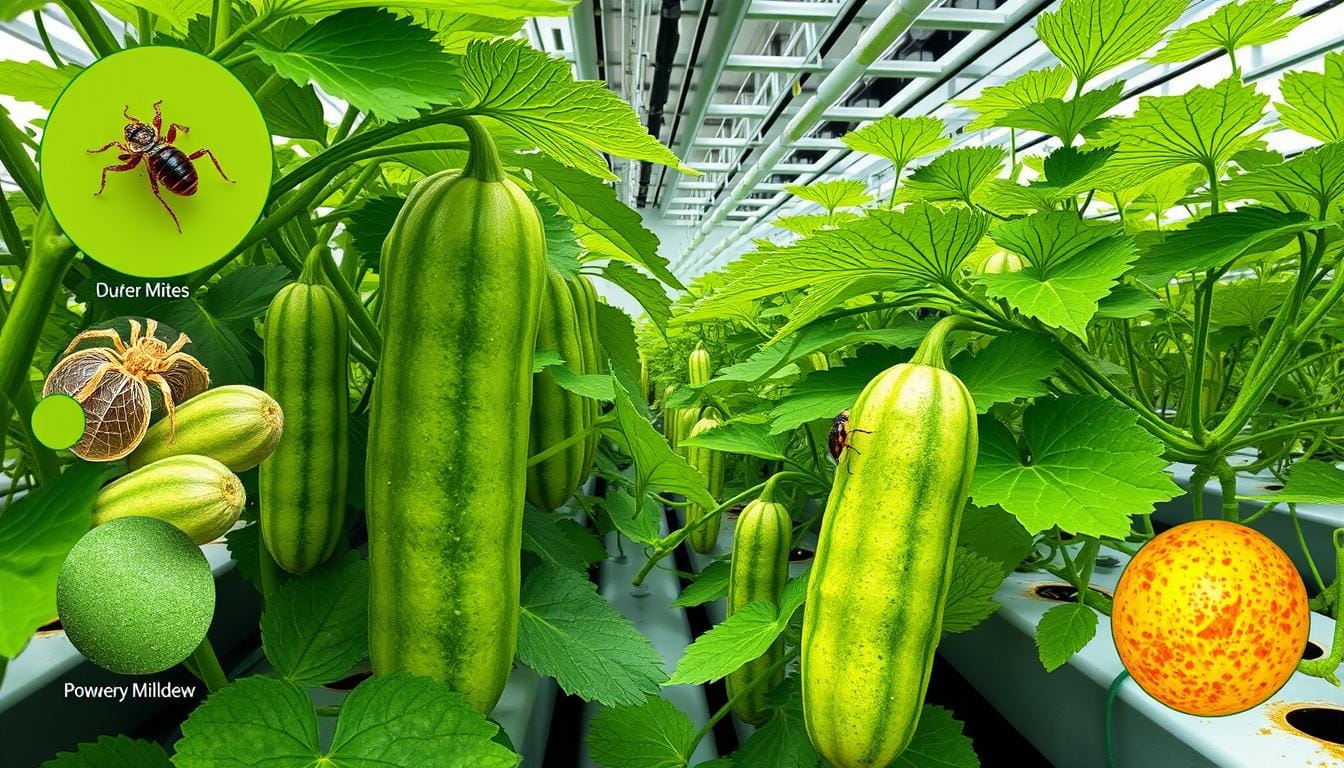I’ve always had a love for gardening, even in small spaces. The opportunity to grow delicious cucumbers in hydroponics really intrigued me, offering fresh veggies year-round in a compact setup. I was hooked and excited to learn more.
This guide is perfect if you want to grow your food but lack space. I’ll show you how to grow tasty cucumbers hydroponically. We’ll cover everything from picking the right spot to managing nutrients and pollination. Get ready to enjoy your homegrown cucumbers!
Key Takeaways
- Hydroponic cucumber cultivation offers a year-round growing solution in limited spaces.
- Essential steps include choosing the right location, setting up the hydroponic system, preparing the nutrient solution, and starting seeds in rockwool cubes.
- Proper transplanting techniques, support system installation, and maintaining optimal environmental conditions are crucial for successful growth.
- Regular monitoring of nutrient levels, pollination methods, and harvesting best practices ensure a bountiful and healthy harvest.
- Hydroponic cucumber farming provides water conservation advantages, space efficiency, and faster growth with higher yields.

Understanding Hydroponic Cucumber Cultivation Benefits
Hydroponic cucumber farming brings many benefits over traditional farming. It saves water, uses space wisely, and grows plants faster. This leads to more crops.
Water Conservation Advantages
Hydroponic systems use water over and over again. They save up to 90% of water compared to soil farming. Cucumbers, which need a lot of water, really benefit from this.
Space Efficiency Benefits
Hydroponics works well in vertical spaces. This is great for city farmers or those with little land. Growers can stack beds or use wall systems to grow more cucumbers in small areas.
Faster Growth and Higher Yields
Hydroponic cucumbers grow 50% faster than soil-grown ones. They can be ready to harvest in 35-45 days, unlike 50-70 days in soil. They also produce more per plant, up to 4-5 lbs/ft².
Using hydroponics, cucumber farmers save water, use space better, and grow more. They get a big harvest of fresh, quality cucumbers.
Essential Equipment and System Setup Requirements
Growing cucumbers hydroponically needs special equipment and a well-planned system. this fosters robust growth and optimizes yield potential. You can use the Nutrient Film Technique (NFT), Deep Water Culture (DWC), or Dutch Bucket systems for cucumbers.
The NFT system is good at using nutrients and water but needs careful temperature control. DWC gives plants constant nutrient access but requires precise water temperature control. The Dutch Bucket system lets you care for each plant and grows with your needs.
Choosing your hydroponic system is important. You’ll also need certain equipment and tools for a successful cucumber hydroponics setup. These include:
- pH and EC meters to check nutrient balance and acidity
- Thermometers to track temperature and humidity
- Grow lights to give plants enough light
- Climate control systems to keep temperature and humidity right
By picking the right hydroponic system and getting the right tools, you’re ready to grow lots of cucumbers. You’ll save water and space, too.
| Hydroponic System | Advantages | Disadvantages |
|---|---|---|
| Nutrient Film Technique (NFT) | Efficient nutrient and water usage | Requires temperature management |
| Deep Water Culture (DWC) | Constant nutrient access for plants | Needs water temperature control |
| Dutch Bucket System | Allows for individual plant care, easily scalable | May require more maintenance and space |
Choosing the Right Cucumber Varieties for Hydroponics
Choosing the right cucumber varieties for hydroponics is key to success. Parthenocarpic varieties, which don’t need pollination, work well indoors. Muncher, Tasty Green, and Diva are popular choices for their taste and texture.
Traditional varieties need pollination to grow fruit. Growing 2-3 plants and staggering plantings helps. This ensures you have both male and female flowers at the right time.
Parthenocarpic Varieties
- Muncher: Nearly seedless with a mild flavor
- Tasty Green: Japanese cucumber, long and sweet
- Diva: Smooth skin and crisp texture
Traditional Cucumber Types
These varieties need manual pollination but can do well in hydroponics. Staggering plantings helps ensure you have both male and female flowers.
Best Performing Cultivars
| Variety | Characteristics | Ideal for Hydroponics |
|---|---|---|
| English Cucumbers | Thin-skinned with few seeds, suitable for raw consumption | Yes |
| Japanese Cucumbers | Long and slim with thin skin and few seeds, ideal for raw consumption or Japanese dishes | Yes |
| Persian Cucumbers | Small and sweet with thin skin, excellent for salads and raw consumption | Yes |
| Gherkins/Cornichons | Very small and crisp, commonly used for pickling or appetizers | Yes |
By choosing the right cucumber varieties for your hydroponic system, you can improve your hydroponic cucumber cultivation and cucumber hydroponic yield. This leads to a bountiful and delicious harvest.
Creating the Perfect Growing Environment
To grow thriving hydroponic cucumbers, you need the right conditions. It’s key to keep the temperature, humidity, and light levels just right. This helps the plants grow well.
Keep daytime temperatures between 21-27°C (70-80°F) and nighttime temperatures at 18-20°C (64-68°F). This helps the leaves grow strong and the plant stay healthy. Also, keep the humidity at 60-70% to help the plants breathe and avoid fungal problems.
Give your hydroponic cucumber plants 14-16 hours of bright light every day. Use full-spectrum grow lights indoors. Make sure the light is strong enough, around 500-700 µmol/m²/s. Place the plants 8-12 inches apart and use trellises to help them grow.
Keep the nutrient solution’s temperature between 18-22°C (64-72°F). This stops the roots from getting stressed and keeps diseases away. Changes in temperature can affect how well the plants take in cucumber hydroponic nutrients.
| Hydroponic System | Suitability for Cucumbers | Advantages | Challenges |
|---|---|---|---|
| Nutrient Film Technique (NFT) | Suitable | Water and nutrient conservation, continuous recirculation | Potential for pump clogs and power outage disruptions |
| Ebb and Flow | Suitable | Versatile for various plants, efficient irrigation | Dependency on electricity and timers, potential for waterlogging |
| Wick System | Not Suitable | Low cost, no electricity required | Not suitable for high water-demanding plants like cucumbers |
| Deep Water Culture (DWC) | Suitable | Simple, efficient, supports rapid growth | Requires continuous power supply to prevent root oxygen deficiency |
By setting up the perfect growing space, you can make the most of your hydroponic cucumber growing guide. You’ll get a big harvest of tasty, healthy cucumbers.
How to Grow Delicious Cucumbers in Hydroponics
Growing cucumbers hydroponically saves water and space. It also makes them grow faster. Here’s how to do it:
Seed Starting Process
Start with cucumber seeds in rockwool cubes or seed starting media. Keep the temperature between 70-85°F (21-29°C) for best germination. When seedlings have 2-3 true leaves, they’re ready for the hydroponic system.
Transplanting Techniques
When transplanting, carefully place the roots in the hydroponic system. For NFT systems, put roots in nutrient channels. DWC systems suspend roots in nutrient solution. Dutch Bucket systems use individual buckets with growing medium.
Support System Installation
- Install trellises or stakes for vertical support. Give each plant up to 6 feet of space.
- Space plants well for air circulation and disease prevention.
Follow these steps for a successful hydroponic cucumber garden. Keep an eye on your plants and adjust conditions for a great harvest.
Nutrient Solution Management and pH Balance
Keeping your hydroponic cucumber plants healthy means balancing their nutrient solution. You need to watch and adjust the levels of nutrients like nitrogen, phosphorus, and potassium. Also, don’t forget about micronutrients like calcium and magnesium.
At the seedling stage (0-3 weeks), keep the nutrient levels in these ranges:
- Nitrogen (N): 50-70 ppm
- Phosphorus (P): 20-30 ppm
- Potassium (K): 50-70 ppm
- Calcium (Ca): 40-50 ppm
- Magnesium (Mg): 20-30 ppm
- pH Level: 5.5-6.5
- EC Level: 1.5-2.5 mS/cm
When your cucumbers grow into the vegetative stage (4-6 weeks), increase some nutrients:
- Nitrogen (N): 100-150 ppm
- Phosphorus (P): 30-50 ppm
- Potassium (K): 150-200 ppm
- Calcium (Ca): 100-150 ppm
- Magnesium (Mg): 40-60 ppm
- pH Level: 5.5-6.5
- EC Level: 1.5-2.5 mS/cm
In the fruit setting stage (7-10 weeks), boost potassium and calcium for better fruit growth:
- Nitrogen (N): 120-180 ppm
- Phosphorus (P): 40-60 ppm
- Potassium (K): 200-250 ppm
- Calcium (Ca): 150-200 ppm
- Magnesium (Mg): 50-70 ppm
- pH Level: 5.5-6.5
- EC Level: 1.5-2.5 mS/cm
For the harvesting stage (11+ weeks), adjust the nutrients for ongoing fruit production:
- Nitrogen (N): 100-150 ppm
- Phosphorus (P): 30-50 ppm
- Potassium (K): 200-250 ppm
- Calcium (Ca): 150-200 ppm
- Magnesium (Mg): 50-70 ppm
- pH Level: 5.5-6.5
- EC Level: 1.5-2.5 mS/cm
Use filtered or RO water to avoid mineral buildup. Change the nutrient solution every 10-14 days. Make sure to oxygenate the solution with air stones. Check and adjust pH and EC levels at least twice a week.

By keeping the nutrient solution balanced and pH levels right, your hydroponic cucumber growing guide will help your plants thrive. They’ll produce a lot of cucumber hydroponic nutrients.
Light Requirements and Temperature Control
To grow tasty hydroponic cucumbers, you must focus on their lighting and temperature needs. They need the right light and a specific temperature range to grow well and produce lots of fruit.
Optimal Light Exposure
Hydroponic cucumber plants need 12 to 16 hours of strong, direct light each day. Use grow lights with at least 40 watts per square foot to mimic sunlight. As they grow, you might need to change the light’s intensity to help them grow evenly.
Temperature Range Management
Cucumbers like daytime temperatures between 70-80°F (21-27°C) and cooler nights of 64-68°F (18-20°C). Keeping these temperatures helps them grow healthy. Use heaters and fans to keep your indoor hydroponic area at the perfect temperature.
Humidity Control Methods
Hydroponic cucumbers also need a humid environment, best between 50-70% humidity. Fans help move the air and prevent fungal diseases. Use humidifiers or dehumidifiers to keep the humidity just right for your cucumbers.
By giving your hydroponic cucumbers the right light, temperature, and humidity, they’ll grow well and produce lots of fruit. Watch and adjust these conditions as they grow to help them reach their best.
Plant Training and Maintenance Techniques
Growing hydroponic cucumbers needs careful attention to training and maintenance. Proper pruning and training help your cucumber vines grow strong. They also improve air flow and boost fruit production.
Vertical Vine Training
Use sturdy trellises or vertical supports for cucumber vines to climb. Attach the main stem to the trellis with soft ties. This keeps the leaves off the ground, improving air flow and reducing disease.
Pruning for Yield Optimization
- Prune side shoots and suckers to focus energy on main stem and fruit.
- Trim lower leaves to reduce the risk of disease and enhance air circulation.
- Remove damaged or yellowing leaves to maintain the plant’s overall health.
Watch for signs of nutrient issues like yellow leaves or slow growth. Adjust your nutrient solution to keep your plants healthy and productive.
Manual Pollination
For some cucumber varieties, hand-pollination is key to fruiting. Use a small brush or gently shake the plants to transfer pollen.
| Hydroponic Cucumber Pruning and Training Tips | Cucumber Hydroponic Yield Optimization |
|---|---|
|
|
Using these techniques in your hydroponic cucumber growing will help you get the most out of your harvest. Enjoy a crop of fresh, tasty cucumbers.
Managing Pests and Diseases in Hydroponic Cucumbers
Growing hydroponic cucumbers has its challenges with pests and diseases. But, with the right steps and natural methods, you can fight off common problems. This keeps your cucumber crop healthy and thriving.
Common Pest Identification
Hydroponic cucumber systems face pests like aphids, spider mites, and whiteflies. These pests harm leaves, stems, and fruits if not stopped early. Spotting them early and acting fast is crucial.
Disease Prevention Strategies
Fungal and bacterial diseases, such as powdery mildew and root rot, affect hydroponic cucumbers. Keeping humidity levels right, ensuring air flows well, and cleaning the system often can prevent these diseases.
Natural Control Methods
For pest control, natural predators like ladybugs are great. They eat aphids and other soft-bodied insects. Organic pesticides or neem oil can help with big infestations. Also, watching plants daily and isolating sick ones quickly stops diseases from spreading.
By taking these steps and using natural methods, you can manage pests and diseases in your hydroponic cucumbers. This guarantees a thriving, abundant harvest.
| Pest/Disease | Symptoms | Control Methods |
|---|---|---|
| Aphids | Stunted growth, leaf curling, and sticky honeydew secretions | Introduce ladybugs, use insecticidal soap or neem oil |
| Spider Mites | Fine yellow or white spots on leaf undersides, webbing on leaves | Increase humidity, use predatory mites, or apply insecticidal oils |
| Powdery Mildew | White, powdery fungal growth on leaves and stems | Improve air circulation, use baking soda or sulfur-based fungicides |
| Root Rot (Pythium) | Wilting, discolored roots, and rapid plant decline | Maintain proper pH and nutrient levels, use Trichoderma or Bacillus-based products |

“Effective pest and disease control is essential for successful hydroponic cucumber farming. By staying vigilant and employing a combination of preventive measures and natural control methods, you can ensure a bountiful and healthy crop.”
Pollination Methods and Fruit Development
In hydroponic cucumber farming, pollination is key for the best yields. Some cucumbers grow fruit without pollination, but others need it. Traditional cucumbers need manual pollination to grow fruit well.
To pollinate cucumbers, find the male and female flowers. Male flowers have thin stalks, while female flowers have a small cucumber shape. Use a soft brush or your fingers to move pollen from male to female flowers. Do this every day when flowers are out to help fruit grow.
After pollination, watch how the fruit grows. Ensure the plants receive the proper nutrients for optimal growth. Remove any bad or misshapen fruits to help the plant grow better ones.
To protect the stems and help cucumbers grow, use slings or netting. These tools help your cucumbers grow big and strong, giving you a great harvest.
| Pollination Method | Percentage of Plants Requiring |
|---|---|
| Insect Pollination | 40% |
| Wind Pollination | 20% |
| Self-Pollination | 30% |
| Cross-Pollination | 10% |
Getting pollination right is crucial for a good hydroponic cucumber yield. By following these tips, your hydroponic cucumber cultivation will be successful and fruitful.
“Proper pollination significantly impacts the development of healthy and large cucumbers.”
Harvesting and Storage Best Practices
Getting your hydroponic cucumbers ready for harvest and storage is key. It helps keep your produce fresh and of high quality. Let’s look at the best ways to harvest and store your cucumbers.
Harvesting Cucumbers
Timing is everything when picking hydroponic cucumbers. The best time is when they’re the right size, usually 50-70 days after planting. Use sharp, clean shears to cut them from the vine, leaving a bit of stem.
This gentle method keeps the cucumber intact and encourages more growth. Regular picking also helps keep your cucumbers coming.
Storing Cucumbers
Keeping cucumbers fresh is crucial. Store them in a cool, humid place, between 10-12°C (50-54°F) and 95% humidity. This helps maintain their crispness and prevents wilting.
Don’t store cucumbers with fruits that give off ethylene gas, as it can make them spoil faster. For longer storage, try pickling or preserving to keep your cucumbers fresh.
Always clean and sanitize your tools and storage spaces. This stops diseases and keeps your cucumber plants healthy.
| Harvesting Recommendations | Storage Recommendations |
|---|---|
|
|
By following these hydroponic cucumber harvesting and storage tips, you can keep your cucumbers fresh for a long time.
Conclusion
Hydroponic cucumber cultivation saves water and space, and it yields more. To grow cucumbers successfully, you need to set up your system right. You also have to control the environment, manage nutrients, and take care of your plants.
Stay vigilant with your plants and adjust care routines as needed to ensure their health and growth. This way, you can get the most out of your hydroponic cucumbers.
Growing cucumbers hydroponically has big benefits. These systems use much less water than traditional gardening. Plus, the plants grow faster and produce more.
With the right setup and care, you can grow cucumbers all year. This remains true even during unfavorable weather conditions.
To grow great hydroponic cucumbers, you must pay attention to details. Choose the right varieties and manage your nutrient solution well. Also, keep pests and diseases under control.
By following this guide, you’ll be on your way to a big harvest. You’ll enjoy delicious and healthy hydroponic cucumbers.
